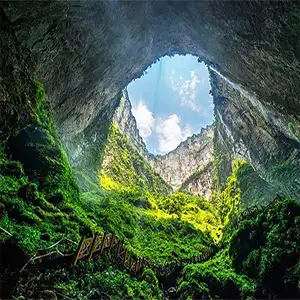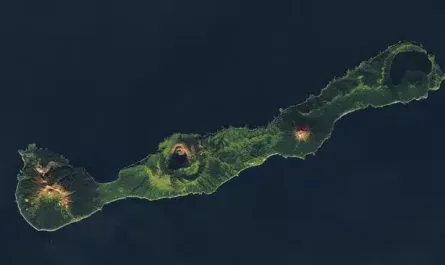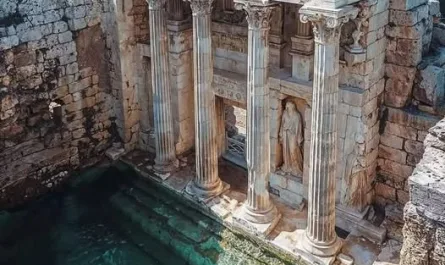In the lush, forested hills of southwestern China, a massive chasm gapes open, its sheer walls swallowing light into a void nearly half a mile wide. Xiaozhai Tiankeng, or the “Heavenly Pit,” holds the title of the world’s largest sinkhole, a natural wonder that captivates with its scale and mystery. Known to locals for centuries, it remained hidden from the global stage until British cavers stumbled upon it in 1994, unveiling a geological marvel.

A Colossal Natural Sculpture
Xiaozhai Tiankeng plunges 2,172 feet from rim to base—deeper than six Statues of Liberty stacked end to end—and encloses a staggering 4.2 billion cubic feet of space. Its vast dimensions, stretching 1,676 to 2,054 feet long and 984 to 1,762 feet wide, make it the planet’s deepest and most expansive sinkhole, a silent giant carved into the Earth.
The Making of a Tiankeng
Geologists describe Xiaozhai as a masterclass in karst topography, where soluble rocks like limestone dissolve over millennia. For roughly 128,000 years, rainwater, infused with carbon dioxide from the soil, turned slightly acidic and seeped into fractures in Triassic limestone beneath Fengjie County. Slowly, it eroded underground caverns until the surface collapsed, forming the dramatic pit we see today. Elevated above sea level and free of clay impurities, the limestone allowed water to carve unobstructed, creating channels that still feed subterranean streams.
Inside China’s mysterious sinkhole
Karst Landscapes Explained
Karst topography emerges when water dissolves soft rocks like limestone, dolomite, or gypsum. Rainwater, mildly acidic from absorbing carbon dioxide, erodes these rocks over time, sculpting sinkholes, caves, and underground rivers. These features thrive in rainy, carbonate-rich regions, where the land is reshaped into dramatic, hollowed-out landscapes. Xiaozhai Tiankeng is a textbook example, amplified by monsoon rains and perfect geological conditions.

A Name That Echoes Its Majesty
Chinese geologists classify Xiaozhai as a tiankeng—a term for sinkholes at least 328 feet deep and wide, with a river at their base. Meaning “heavenly pit” or “sky hole,” the name captures the awe of gazing into its depths. Of the 75 known tiankengs worldwide, about 50 lie in China’s humid karst zones, but Xiaozhai dwarfs them all, meeting every geological criterion with room to spare.

A Vertical World of Terraces and Waterfalls
The sinkhole features two massive “bowls,” each dropping over 984 feet, stacked within its depths. After heavy rains, a seasonal waterfall cascades over the rim, streaming down the sheer walls before disappearing into the rock. At the base, a stream emerges briefly, plunging 151 feet in a single leap that reverberates through the chasm. Descending the pit is no small feat—concrete stairs wind along the cliffs, though researchers often rappel in, equipped with scientific gear to study this vertical realm.

A Thriving Ecosystem
Despite the depth, sunlight filters into Xiaozhai, sustaining a lush ecosystem of ferns, mosses, and ancient ginkgo biloba trees. Biologists have documented 1,285 species, including the rare clouded leopard, whose global population may be under 10,000. The sinkhole’s humid, stable microclimate fosters orchids, amphibians, and winged insects, with each tier hosting distinct ecological communities, like altitudinal zones on a mountain. For scientists, it’s a natural laboratory for studying evolution in isolated conditions.
The River Below
At the base of the second bowl, the Difeng cave opens, engulfing a stream that has journeyed 5.3 miles underground. This water, after its dramatic 151-foot plunge, vanishes into the rock, reemerging downstream at the Migong River’s cliffs. Mapping this subterranean river has proven challenging—speleologists have faced roaring waters and unpredictable surges, leaving parts of the system uncharted, a testament to nature’s untamed complexity.
Science Meets Mystique
Researchers from Chongqing’s Institute of Karst Geology, often with international teams, study Xiaozhai using radar probes, climate loggers, and isotopic dating to pinpoint its origins. Their work informs global climate models and groundwater protection strategies, as pollutants in karst regions can spread rapidly. Yet, the sinkhole retains an air of enchantment. Local legends speak of dragons lurking in its depths or celestial gates behind the waterfall. Trekkers describe an eerie silence at the bottom, punctuated only by dripping water or a bat’s wings.
Xiaozhai Tiankeng draws scientists, adventurers, and travelers, each pulled by its blend of raw data and timeless mystery. It stands as a monument to nature’s patient craftsmanship, where water, rock, and time have sculpted a window into the Earth’s hidden depths.


